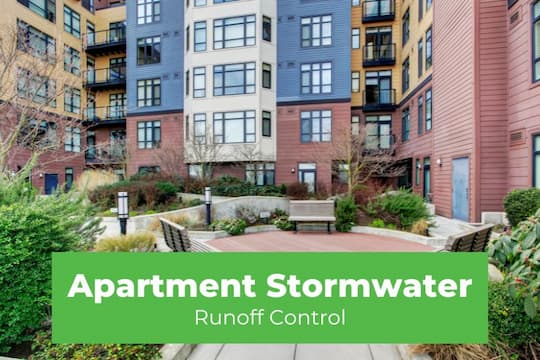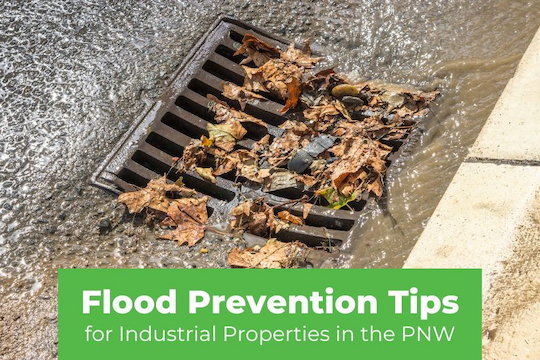The next time it rains, watch where the stormwater flows. Does your property soak up the rain, or is the water directed through a downspout, across paved areas, and washed down the storm drain?
When rainwater runs off impermeable surfaces like streets, roofs, and parking lots, it picks up debris, fluids dripped by cars, and many other pollutants. The polluted water often winds up in local streams, lakes, and the ocean with minimal or no treatment.
Allowing runoff into local water bodies also starves underground aquifers that would typically get replenished from rainwater soaking down through the soil and other permeable surfaces.
The following top ways to reduce stormwater runoff can help make good use of this resource while reducing the runoff and pollution that makes its way into water bodies, destroying aquatic life and more.
Care for Your Lawn's Bare Spots

Most people prefer lawns with low-maintenance beauty for their homes or commercial properties. Grass does a great job of stopping stormwater and providing a large surface to soak up the rain.
However, if the lawn has bare spots, the water may run off, especially for lawn areas with a slight grade. The runoff will also carry soil and sediment off the lawn area, which can clog catch basins and cause other problems for stormwater management systems. If you use fertilizer, the runoff will also carry that away, contributing to "nutrient pollution," or too much phosphorous and nitrogen in the water.
Consider reseeding, laying down sod, aerating, or choosing a different grass variety to improve and minimize bare spots in your lawn and reduce runoff.
Use a Mulching Lawnmower
Standard lawnmowers catch grass clippings in a bag and end up in the trash or dumped elsewhere. One of the top ways to reduce stormwater runoff is to use a mulching lawnmower because it chops the lawn clippings into fine pieces and distributes them back onto the lawn. This additional layer of organic material retains the stormwater and slows down the rate of water runoff.
The clippings also act as a composting layer; the matter can cover up bare spots on a lawn to prevent soil from eroding. The improved grass allows more rainwater to stay where it falls and infiltrates the ground below to replenish groundwater stores.
Consider Using Rain Gardens
A rain garden goes a few steps further than a lawn to slow down or prevent stormwater runoff. A rain garden consists of a shallow basin or depression built into the landscape. It typically uses specific soil engineered to drain well, which helps water soak in faster. The rain garden is planted with vegetation that, with the soil, acts as a natural filter to reduce pollutants and sediment from stormwater before it infiltrates the ground.
The location of a rain garden can increase its benefits. Ideally, you would locate it where runoff from driveways, roofs, and other impervious surfaces can flow into the soil depression and soak into the ground. Consider adding native plants that will thrive in the area, which can also provide a natural habitat for butterflies, birds, and other beneficial insects.
Divert or Disconnect Downspouts
A downspout produces a concentrated stream of stormwater that can run across impermeable surfaces or non-vegetated soil to pick up pollutants, cause erosion and allow all the water to flow into storm drains. Instead, downspouts can be redirected toward a rain garden, lawn, or another permeable surface to allow the water to soak in.
Removing a downspout altogether can achieve the same effect if you consider the area's slope, amount of vegetation, and nearby collection areas. Consider applicable local regulations and ensure that a redirected or removed downspout does not cause issues for neighboring properties.
Use Rain Barrels

A rain barrel is a large, durable container designed to catch rainwater for later use. Instead of allowing rainwater to run off your property, direct a downspout to a rain barrel or cistern to capture the water later in irrigation, gardening, or other non-potable uses.
Capturing and using this valuable resource can lower your water bill while providing nutrient-rich water for your garden. It can also reduce the burden on local water supplies and stormwater systems.
Install Permeable Surfaces
Permeable surfaces run the gamut from gravel and crushed stone to cement pavers, permeable concrete, and synthetic, permeable turf. As one of the top ways to reduce stormwater runoff, various permeable surfaces can suit multiple property types and budgets. Commercial properties can use permeable asphalt for parking lots and enhance the property's attractiveness with permeable pavers.
Homeowners can use pavers or various colors and textures of gravel and crushed rock to add decorative or functional features to their landscape. Permeable synthetic turf can provide an alternative for play areas such as playgrounds, sports fields, and other places where natural grass may not be an option.
Keep Areas Clean of Pollutants

While these tips may not reduce the amount of stormwater runoff from your property, they can reduce the amount of pollutants the water carries away, which improves conditions downstream.
Take the following actions to ensure that, whether the water comes from a storm, sprinklers, or a garden hose, any runoff water stays cleaner.
- Sweep streets and paved areas of trash, organic matter, and debris regularly
- Do not dump anything into storm drains
- Use lawn and garden fertilizers sparingly
- Repair any leaking fluids from vehicles
- Wash cars at a car wash instead of in the driveway
Managing Your Stormwater
Stormwater is an essential resource, and finding ways to let it soak in where it lands or collect it for future use can benefit your property and the environment in many ways. When stormwater runs off and goes through the stormwater management system, storm drain companies remove sediment, trash, and debris from storm drains and pipes, perform catch basin cleaning, and other essential services that reduce pollutants in the runoff.
If you're looking for quality, professional stormwater system maintenance and repair services, don't hesitate to contact CatchAll Environmental. Put your trust in us—your property and the environment will thank you.













